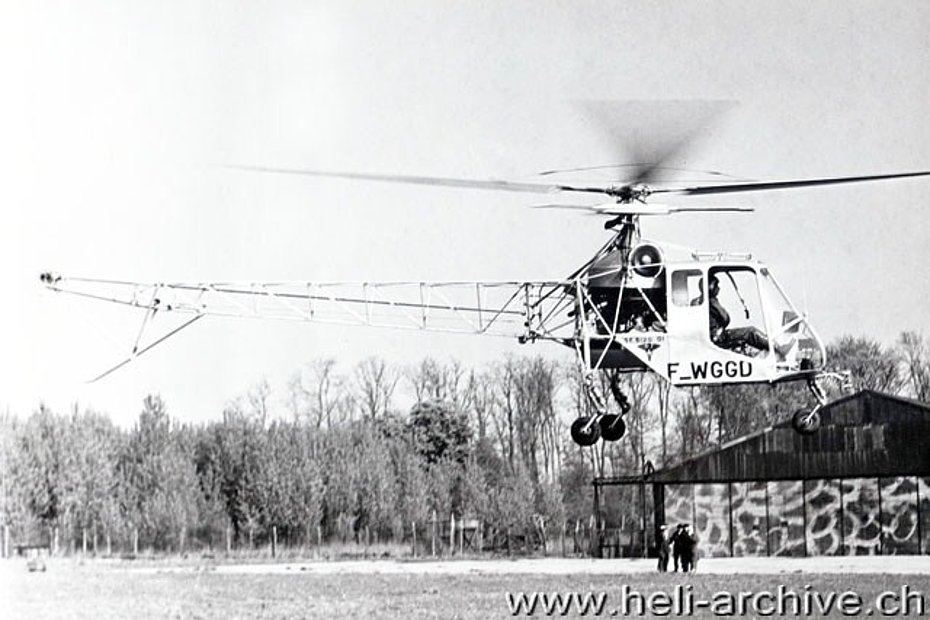
SE 3130 Alouette 2 - History and technical description
The Alouette 2 is the forerunner of a fortunate series of French light helicopters. It accomplished its maiden flight on the 12th of March 1955 at the airfield of Buc near Paris in the hands of famous French test-pilot Jean Boulet (1920-2011). On the contrary to most of its competitors this aircraft was powered by a turboshaft instead of a conventional piston engine. That first flight marked the beginning of a fortunate career.
The origins
The Alouette 2 is an improved version of the SE 3120 Alouette 1 which flew for the first time on the 31st of July 1951 piloted by Henri Stackenburg.
The Alouette 1 was a three-seater helicopter of standard design (single main and tail rotor) and construction. It was powered by a 149/200 kW/shp 9 cylinders radial Salmson 9NH radial engine. Two prototypes registered F-WGGD and F-WGGE were built and extensively tested with good results. In July 1953 Jean Boulet even set some official world records piloting this helicopter.
Despite its good general performances Sud-Est decided to not produce this model.
The Alouette 1 did not offer anything more in terms of payload and performances than the Bell 47 and Hiller UH-12, which were both appreciated by operators. In order to meet a joint requirement for the Air Force, Army and Navy, as well as establish a niche in the industry SNCASE proposed a five-seater helicopter, a new class of helicopter between the three-seater already mentioned and the ten-seater Sikorsky S-55.
With its decision the French manufacturer made a step forward. Its idea was to take advantage against the American manufacturers by producing a new helicopter powered by a turboshaft.
At the beginning the group of technicians headed by the chief-project Charles Marchetti tought to re-engine the SE 3120 with a Turboméca Artouste I. However this project was soon abandoned in favour of a new helicopter design, quite similar in its general aspect to its predecessor, but designed since the beginning to be powered by a Turboméca Artouste I.
For the chronicle it must be said that this idea was not really new at that time. In fact, Kaman (K-225 - 1951), Sikorsky (S-59 – 1954) and Bell (XH-13F - 1954) were the first to pave the way to turboshaft-powered helicopters. But none of these prototypes led to a production and they were abandoned after completion of their test programs.
This was the main reason why the French team decided to develop the Alouette 2.
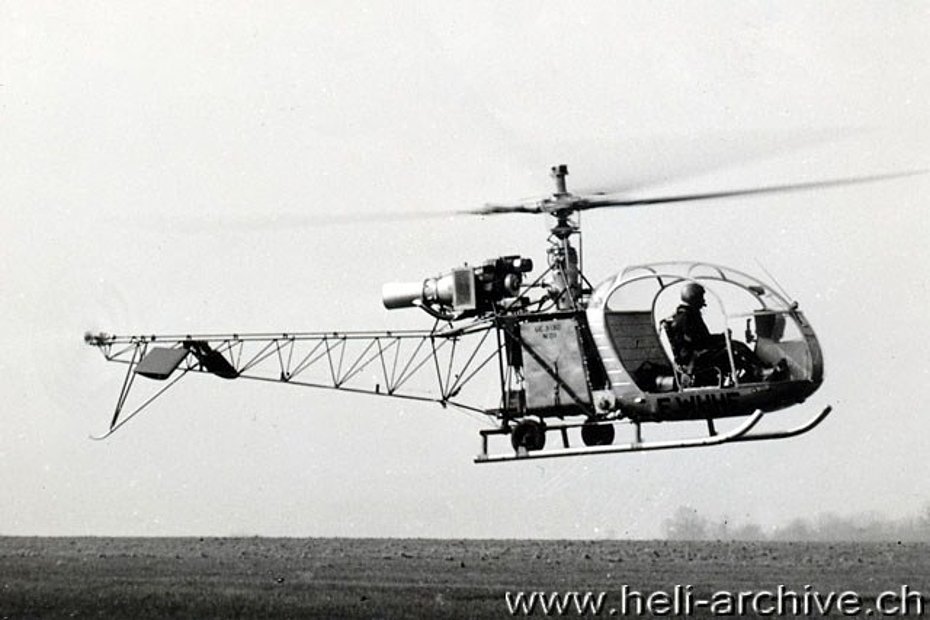
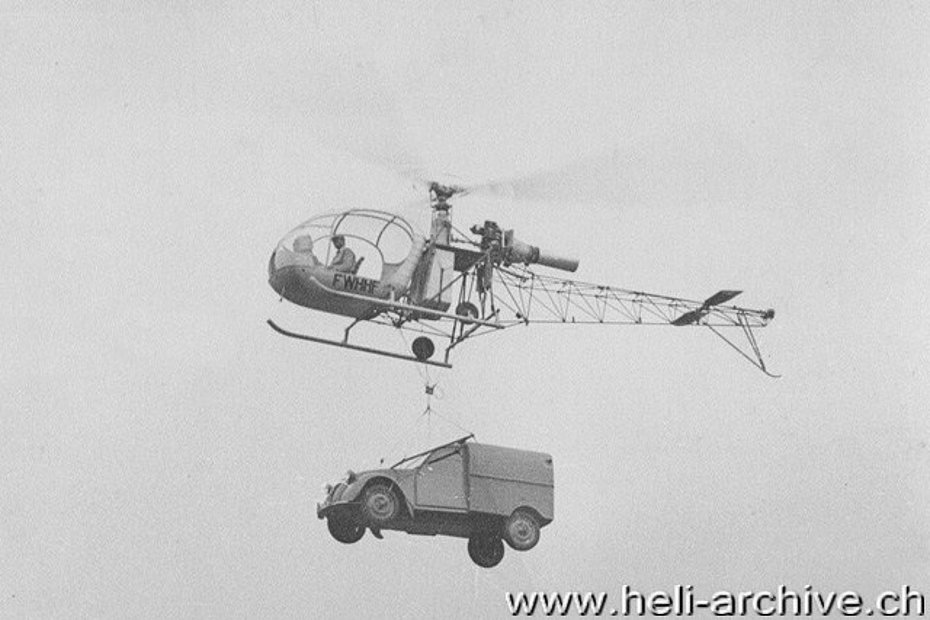
First flights, certification and start of the mass production
As already said the first prototype of the SE 3130-01 F-WHHE made its inaugural flight on the 12th of March 1955. It was followed by a second prototype (F-WHHF) which started the first test flight on May of the same year. A few days later, on the 6th of June 1955, the new prototype piloted by Jean Boulet set up a new world altitude record by reaching 8'209 meters (26'932 ft).
Both helicopters started an intense and demanding evaluation program. Before the end of the year the first pre-series model (F-YDJF) was also completed before the end of the year, while two more were readied for the tests during the next Spring.
In June 1956 the Alouette 2 was at first tested in the Sahara's desert and then on the Mont Blanc massif. Here is was used experimentally to transport supplies to the Vallot refuge at an elevation of 4'362 meters (14'316 ft) and also to rescue a Swiss mountaineer.
During 1956 the helicopter officially received its designation and since that moment it became the SE 3130 Alouette 2. Mass production was also started and 32 aircraft were completed by the end of the year.
At the same time the flight test program continued because Sud-Est wanted to sell the new helicopter not only to military customers but also to civil operators and for this a Type Certificate from the Secrétariat Général à l'Aviation Civile, nowadays known as the Direction générale de l'Aviation civile - DGAC was needed. This important document was granted to Sud-Est on the 2nd May 1957, only 13 months after the first flight!
Two months earlier on the 1st March 1957 the Société nationale des constructions aéronautiques du Sud-Est (also commonly known as Sud-Est) merged with the Société nationale des constructions aéronautiques du sud-ouest (which was producing the SO 1221 Djinn), to form a new entity named "Sud Aviation".
On the 14th January 1958 the Federal Aviation Agency issued to Sud Aviation the Type certificate 7H1, and the Alouette 2 became the first turbine powered helicopter to be certified in the United States.
The other versions
In addition to the SE 3130 Sud Aviation produced the variant SE 313B which is powered by an Artouste II C5 or C6, has reinforced main rotor blades, a body structure reinforced with a transversal bar, a high pitch stop adjusted for 15°, a modified tail rotor and new instruction plates. Thanks to these modifications the MTOW was increased from 1'500 to 1'600 kg.
On the 10th of May 1957 the SE 3131 Gouverneur F-WIEA (then re-registered F-BIEA) a deluxe streamlined version with enclosed tailboom, made its first flight. Only one prototype was built and temporary used for VIP flights. It was developed with the help of famous designer Raymond Loewy.
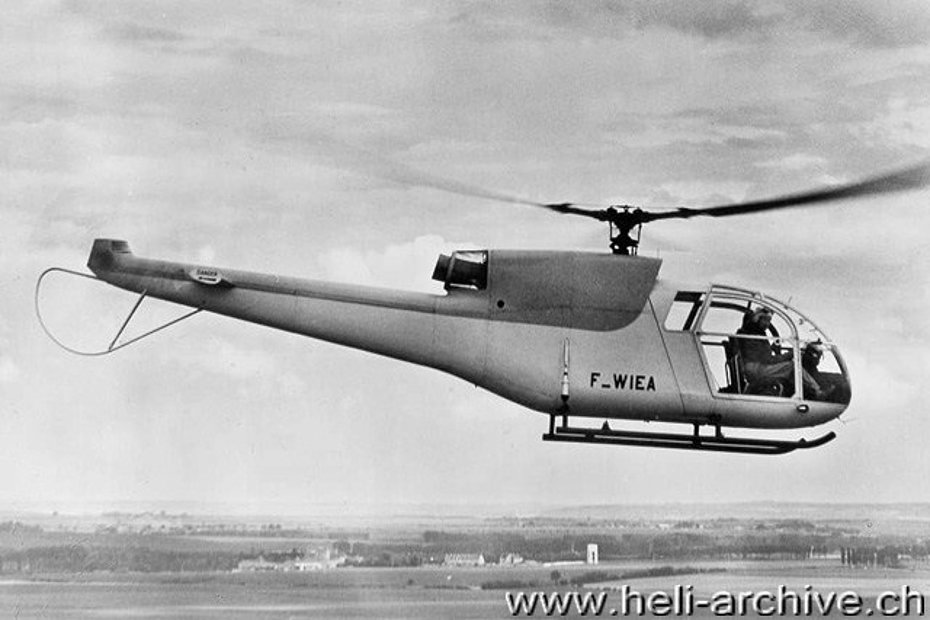
The SE 3140 F-WIEB flew for the first time on the 16th of May 1957 (test pilot Roland Coffignot) and was used as flying testbed for the Turboméca Turmo II freewheel engine. Despite this turbine offered greater flexibility of operation (for example jump take-off were possible without imposing strain on the transmission) the results of the tests were unsatisfatory and this version was abandoned.
On the 11th of March 1958 Jean Boulet achieved the first test flight of the SE 3150 version. This experimental helicopter was powered by a more powerful Turboméca Artouste III engine. Two prototypes were built (one of them was converted from the SE 3140 test airframe) and registered F-ZWVM and ZWVN (the second prototype first flew on the 19th of May 1958 and weared much later the new registration F-ZWVB). They had a longer tail boom and used a larger main rotor. In fact, they were designed as flying test beds for all the dynamic components of the SE 3160 Alouette 3, which was on the drawing boards at that time.
Jean Boulet on the 13th of June 1957 set up a new world altitude record of 10'984 metres (36'050 ft) at the controls of this very powerful helicopter.
Despite its excellent performances (much better than the standard SE 3130), this version never entered in production because the manufacturer wanted to put all his efforts into the new very prospective Alouette III project.
However it is to mention that about ten years later the SE 3150 inspired the development of the Aérospatiale SA 315B Lama.
The production in series of the SE 3130/313B series reduced progressively from 1964 with the introduction of the new SA 3180. This helicopter is powered by a 390/530 kW/shp Turboméca Astazou IIA. In addition it gained the main gearbox and the main rotor shaft unit of the Alouette 3, while retaining the main rotor of the Alouette 2.
There are two more (sub-)variant derived from the SA 3180: the SA 318B and the SA 318C.
The SA 318B, certified on the 18 February 1964, has a MTOW of 1'600 kg and is powered by an Astazou IIA.
The SA 318C is the most performant of all the production Alouette 2 series. It is powered by an Astazou IIA or IIA2 (which has a higher max continuous T4 temperature of 490°C instead of 460°C) and is fitted with a new centrifugal clutch. It also uses several components of the SE 3160 (rotor head, hub and main gear, tail rotor gear and blades). Its MTOW was increased to 1'650 kg and the Vne to 205 km/h.
The first flight of the prototype of this new version (F-WHOF) was completed by Jean Boulet on the 31st of January 1961. At the beginning of 1963 the first new aircraft were delivered to the French armed forces, while the French type certificate was issued on the 18th of February 1964.
The basic version SE 3130 and SE 3180 can be converted into 313B and respectively into 318B or 318C with a series of modification.
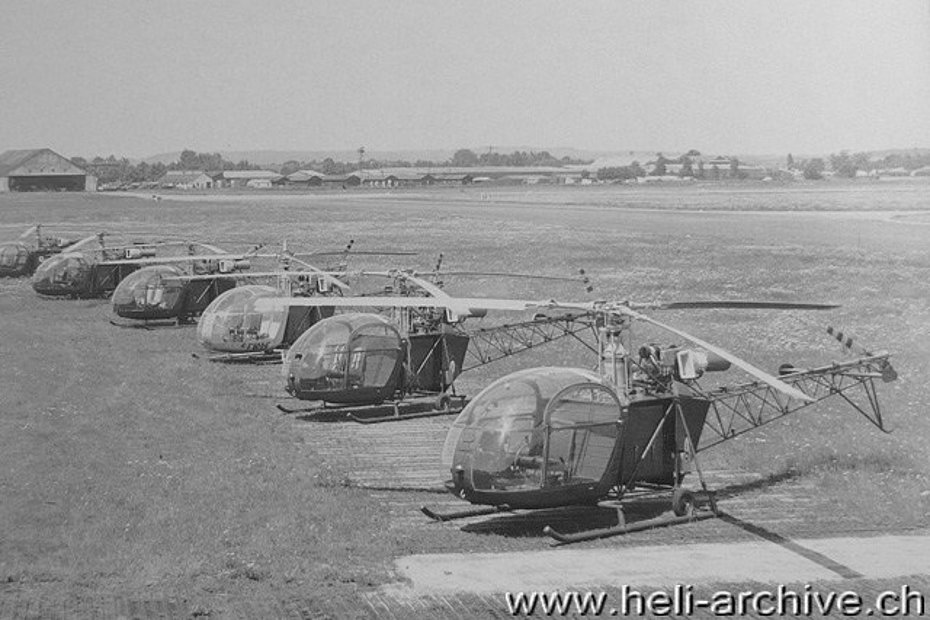
The end of the production
The series production of the Alouette 2, which started in 1956, ceased in the Spring of 1975.
According to information collected, Sud-Est, Sud Aviation and then since 1970 Aérospatiale, altogether manufactured 923 SA 3130/313B and 382 SA 3180/318B/318C Alouette 2s with progressive serial numbers (s/n) between 1001 and 2680.
Main customers were French, German and Belgian armed forces who purchased almost the half of the production.
In Europe the Alouette 2 was also assembled under license in Belgium by the S.A.B.C.A. (Societé anonyme belge de constructions aéronautiques), and in Sweden where SAAB assembled in its plant at Norrköping about ten of the 29 units purchased by its armed forces.
In the United States Republic Aviation Corporation signed an agreement with Sud Aviation and created a new helicopter division with the initial aim to manufacture and sell the French helicopter in the United States, Canada included Alaska, Hawai, Puerto Rico an Central American countries.
About twenty Alouette were assembled (with French components) under license and commercialized since the end of 1957 under the name of "Lark". At least two of them were converted to be powered by American-made engines.
The N-527 was experimentally fitted by Republic with a 373/500 kW/shp AiResearch TSE331-7 turboshaft, while the N-529 was fitted with a with 525 shp Continental Model 217-5A (YT72-T-2). The first test flight occurred on the 12th of October 1961. Apparently only two conversions were completed and the project of an American-engined Alouette 2 was subsequently abandonned.
Civil use
The Alouette 2 has found itself as a versatile helicopter among civil operators. Its multi-role character made it suited for the transportation of passengers and goods, aerial observation, agricultural and forest services, search and rescue operations, off-shore, aerial filming and photography, training.
Despite the long period elapsed from its first flight, there are still some civil operators which are using the Alouette 2. However the majority of the aircraft are now privately owned by helicopter enthusiasts.
SE 3130 Alouette 2 - General description and characteristics
The SE 3130 Alouette 2 is a light multi-role five-seater turbine powered helicopter of standard configuration.
The helicopter is made of three main parts: the cabin, the center frame and the tail boom.
The cabin (dimensions 130 x 196 x 133 cm height) consists of canopy and floor. The canopy has a metal frame which supports the Plexiglas panels. Two large metalframed Plexiglas doors offer unrestricted view in all directions for the pilot and the four passengers.
The two frontal seat (the one on the right is that of the pilot) are adjustable and have a small compartment for the documents. For the frontal seats there is a shoulder harness equipment offered as an optional.
The console which supports the instruments panel is located right on the aircraft center line.
The floor is a rigid box-type construction. Cargo tie-down fittings easily added. Hatch is provided for aerial photography.
A cargo space of 1.70 cubic metres provides for an over 500 kg internal cargo capacity. The rear bench for the three passengers is completely foldable.
A removal panel on underside of the cabin gives quick access to flight and engine controls, electrical and radio circuits. The radio compartment inspection panel is placed in front of the cabin.
The electric energy is provided by a 2'500 watt 28v generator. The 35Ah battery is located in the front of the cabin under the electric panel in a well ventilated space.
The rest of the fuselage, welded tube truss-type, consists of two parts.
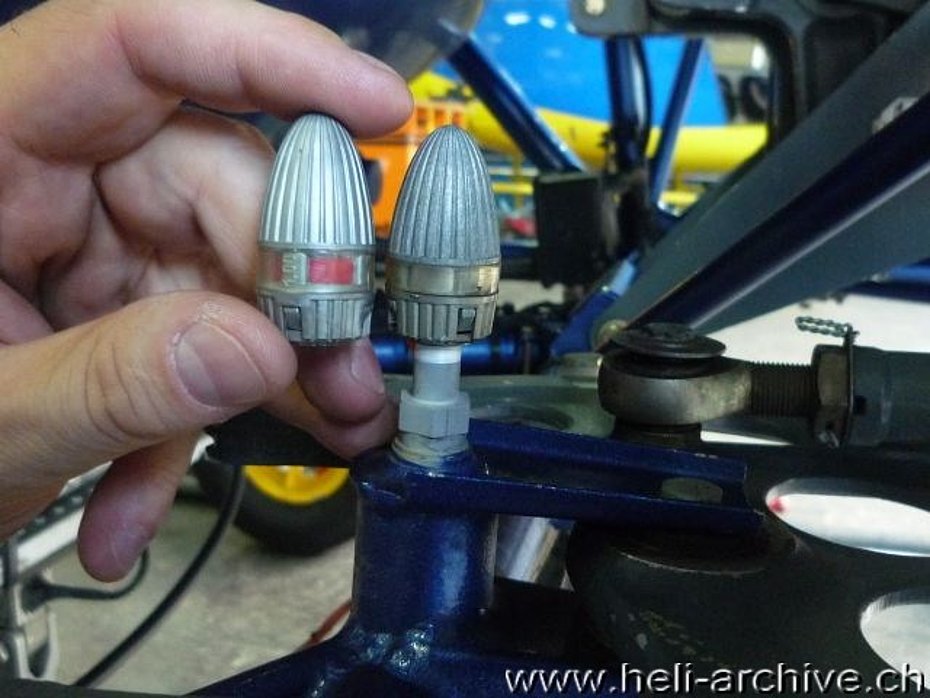
The center structure is made of welded steel tubes covered with two detachable fairings, and a transmission support platform commonly called plancher mécanique which carries other components. The structure encloses a 580 litres capacity squared fuel tank (Jet A-1 kerosene is used) isolated from the power unit by mean of firewalls.
The tail boom is attached to the aft end of center section and supports the fixed stabilizer, the tail rotor gearbox, the tail rotor and its protection arc (quite different in the first models manufactured).
The main frame and the tail boom are made of soldered sealed tubes. Nitrogen is fitted into the tubes. If a leak occurs due to a crack in any of the tubes, air will come inside the tubes and the video-pi indicator will change of colour telling the pilot or the engineer that there is a problem with the main frame or the tail boom. It is a unique and very bright safety device.
The landing gear is made of two flexing cross tubes with hydraulic shock struts designed to absorb landing impact. The two duraluminium tube skids (reinforced with thin steel sheet) curved upward are interconnected by two steel cross tubes attached to the center section. Skids carry each a retractable wheel for ground handling.
The turboshaft is horizontally mounted and is attached to the body structure at three points.
Rotor, transmission and controls
The Alouette 2 has a three blades fully articulated main rotor and a two blades tail rotor. The all light-metal alloy main rotor blades are foldable. Blade folding is effected without removing the equalizer-spacing cables. No adjustments are required after unfolding.
In flight the normal main rotor range is between 350 and 360 rpm. During autorotation variations between 280 and 420 rpm are admitted. The tail rotor is made of two taper plan form blades of metal construction of symmetrical profile and rotates at 2'020 rpm.
The main rotor transmission transmits power to main and tail rotor and consists basically of an input bevel gearing and two planetary reduction stages, with a 1:16.32 reduction ratio between main drive shaft and rotor head, and 1:2.27 between main drive shaft and tail drive shaft. The main drive shaft freewheel unit connect turbine to main gearbox. The tail rotor gearbox provides 1:24 reduction between tail rotor drive shaft and tail rotor and incorporates an axially mounted pitch change mechanism. The freewheel assembly permits autorotation in case of emergency. The helicopter has conventional controls.
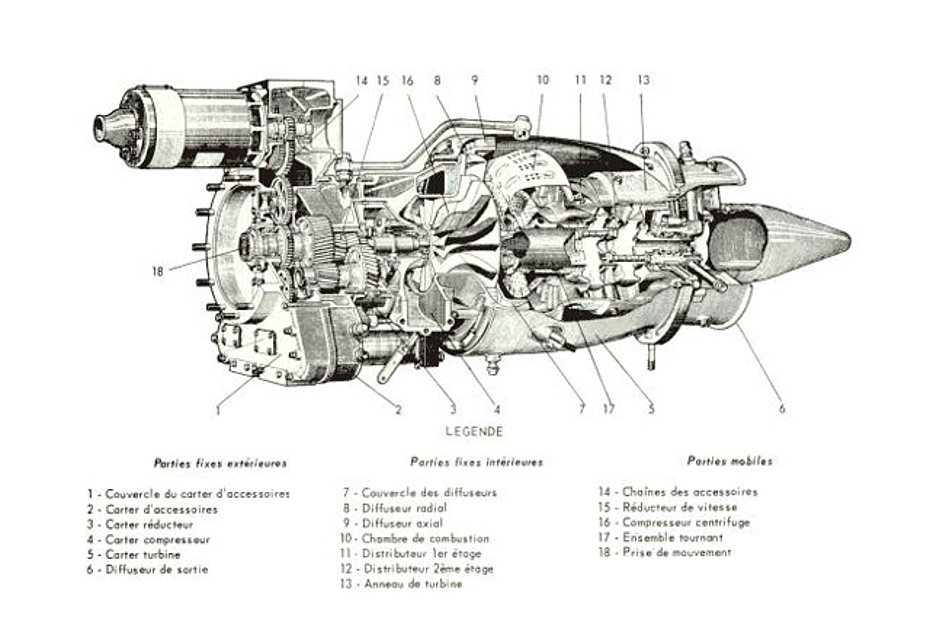
Power plant
The SE 3130 Alouette 2 was originally powered by a 298/400 kW/hp (derated to 269/360 kW/hp) Turboméca Artouste II B1 turboshaft built by Turboméca, a French company founded in 1938 by Joseph Szydlowski, a brilliant engineer of Polish origins.
The predecessor of this turboshaft was the Artouste I appeared in 1947. Originally conceived as an auxiliary power unit (APU), it was soon adapted to aircraft propulsion, and found a niche as a powerplant for turboshaft-driven helicopters.
The Artouste II (built in the B1, C, C1, C2, C5 and C6 version) are single turboshaft engines with an annular air intake, a single stage centrifugal compressor, an annular combustion chamber, a two stage axial turbine and a mechanical control system. A coaxial gearbox reduces the rotation speed for the output shaft and drives the accessories.
The C6 variant is identical to the II C5 except for changes to the air intake and the reduction gear casing that allow easier removal of the gearbox.
The turboshaft is controlled by three levers situated at the bottom of instrument console and connected to the engine trought Teleflex controls. The fuel flow controls the amount of fuel delivered to turbine during acceleration following start-up, and before constant-speed governor takes over. The governor control lever is used to select desired governing speed between 28'000 and 35'000 rpm. Turbine incorporates automatic starting sequence system and is fitted with started-generator of 100 amps - 28V continuous rating. A wet-type centrifugal clutch on the output shaft facilitates start-up and prevents overheating.
Fuel shut-off lever is used in case of emergency.
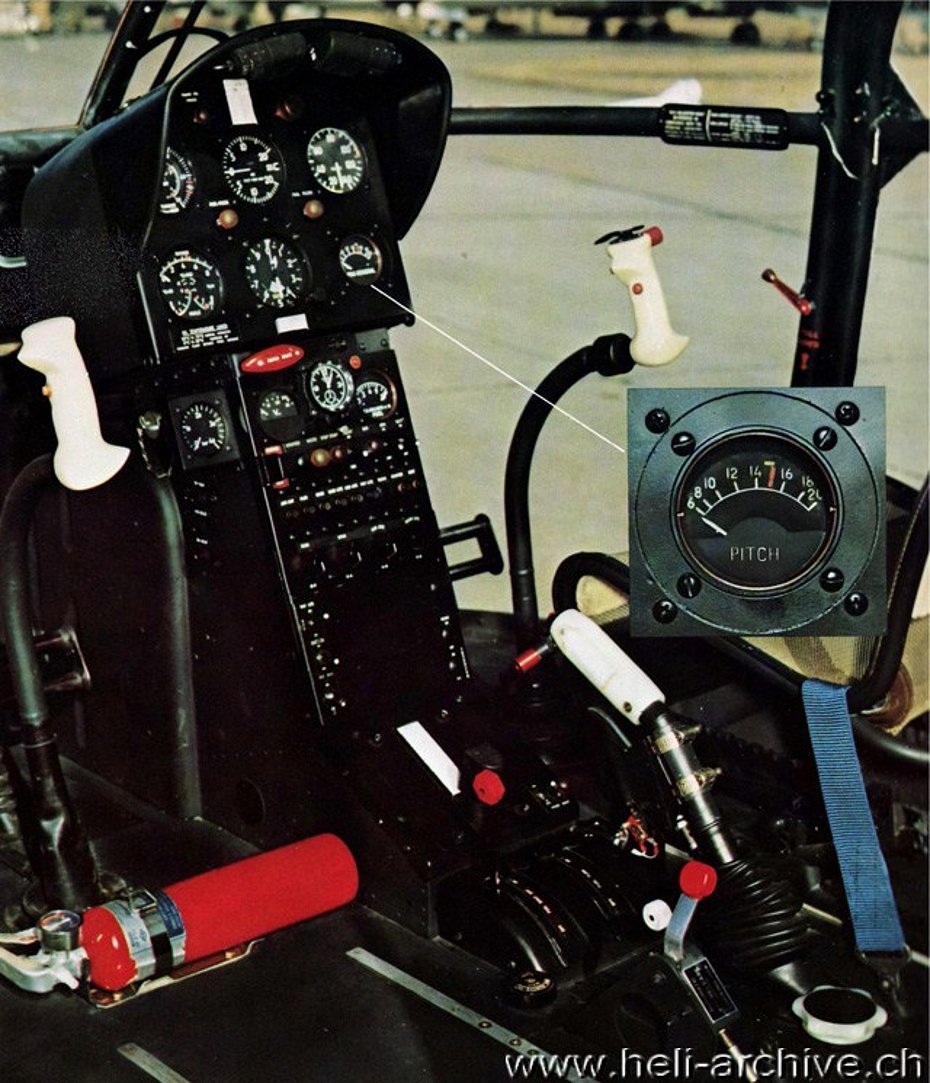
Conventional throttle eliminated
The need of a conventional throttle on the collective pitch lever has been eliminated because the Alouette is powered by a constant speed, fixed turbine which is mechanically connected to the main rotor. Therefore any tendency of the rotor to vary in rpm (33'500 rpm is the constant speed) as the result of the pilot changing collective pitch, is immediately sensed by the turbine's governor which automatically programs fuel to match engine output to power demand, thus maintaining a constant rpm. This correlation between power and collective pitch (very much appreciated by pilot especially when the helicopter is used to carry external cargos) makes possible a definite means of power determination... the collective pitch indicator.
For example, the pilot merely loads and lifts his craft to a hover and checks the collective pitch indicator. If the needle is within half degree of maximum available pitch, he knows he can can transition to forward flight. There is no guesswork involved.
If at the high end of the collective-pitch range, the pilot increases collective pitch too much, and thus demands a greater fuel flow than is available, a prominent red light flashes on the instrument panel to indicate "limite-puissance" (power limit).
If this occurs he must immediately lower the collective-pitch lever slightly until the warning light goes out, or he will be over-pitching the rotor and losing rpm. Over-pitching also causes the danger of a compressor stall with serious consequences, as for example a complete loss of power.
The hourly fuel consumption varies from 125 - 150 kg (160-185 litres). Dry empty weight of the turbine with its accessories is 160 kg.
The Artouste II obtained the Type certificate from DGAC on the 2nd May 1957. It has been manufactured under license in India and Great Britain.
Performances
The SE 3130 powered by a Turboméca Artouste II B1 in standard atmospheric conditions, at its maximum take-off weight of 1'500 kg, has a cruising speed of 170 km/h, while the never exceed speed at sea level is 195 km/h. Its absolute service ceiling is 4'500 meters.
Its range is about 565 km, corresponding to 3h15min of flight endurance.
Dimensions, weights and payload
The main rotor of the SE 3130 Alouette II has a diameter of 10.20 m (disc rotor area 81.75 sq m), while its tail rotor has a diameter of 1.81 m (rotor disc area 2.54 sq m). The fuselage has a length of 9.66 m. The height measured on the top of the rotor mast is 2.75 m.
The aircraft standard empty weight is about 850 kg, while its MTOW is 1'500 kg.
Allowing for a standard pilot weight (77 kg) and with a fuel and oil reserve for one hour of flight (about 150 kg) the helicopter has a payload of 423 kg. It can transport four passengers and 100 kg of baggage, or an under slung load of about 400-450 kg (structural limit is 500 kg).
Optional equipment
The versatility of the Alouette 2 could be further extended using the following main optional equipment: dual controls, rotor brake, heather and defroster, interior casualty carrying equipment (or two external stretcher panniers), hydraulic rescue hoist, cargo sling (Siren Type A21), skis, float landing gear, emergency flotation gear, external cargo carriers, VIP interiors, agricultural kit, boost control (cyclic), night flying kit, tow bar, waterproof covers, portable maintenance hoist, all weather instruments, wheel-type landing gear,
Military helicopters could also be equipped with Nord Aviation SS.10 wire-guided missiles.
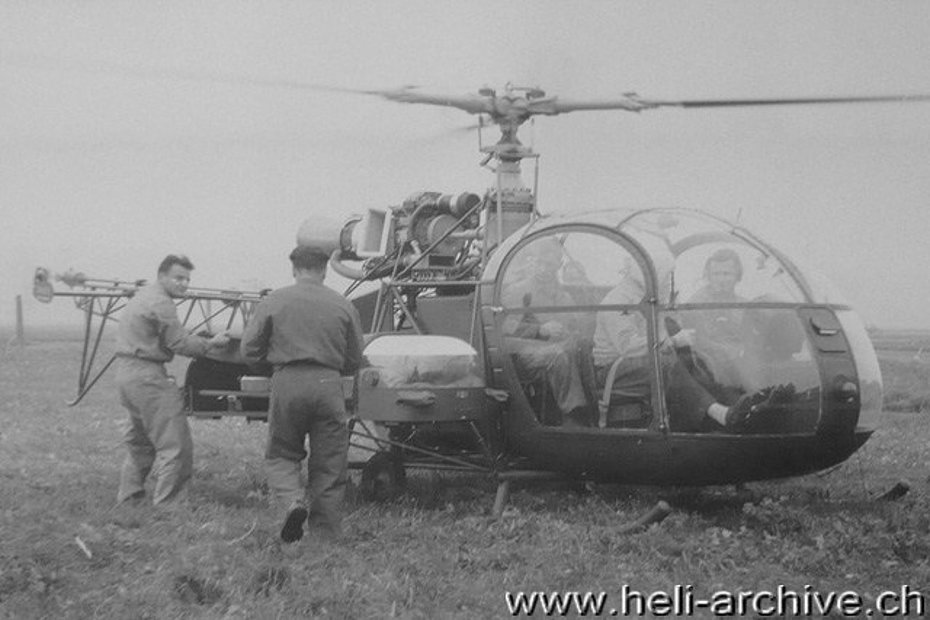
The SE 3130 Alouette 2 in Switzerland
According to my research the Alouette 2 was presented for the first time In Switzerland in October 1956 when the Kriegtechnische Abteilung - KTA (Defence Department), at that time directed by col. brig. Von Wattenwyl, invited Sud-Est to present its new helicopter.
The French manufacturer accepted the invitation by sending Alouette 2 F-WHOF (s/n 1012) which was equipped with a "deluxe" interior and F-ZKBA (s/n 1009) which was nothing else than a military aircraft with a civil registration.
The two helicopters arrived in Switzerland on the 15th of October 1956 piloted by Gérard Henry and Eduard Lucas.
While F-ZKBA was equipped with special precision instruments to record performance parameters Gérard Henry introduced the Swiss military pilot Hansueli Weber to the new helicopter. The latter worked for KTA and was in charge to prepare a detailed evaluation report.
Along with Gérard Henry the Swiss military pilot conducted a series of test flights at various speeds, heights and weights.
On the 17th of October the helicopter took-off from Emmen/LU and reached the Jungfraujoch (3'471 m/asl). Here Henry surprised Weber when he took-off without major problems at a weight of 1'370 kg (MTOW is 1'500 kg), or 100 kg over the weight indicated by Sud-Aviation in the performance chart.
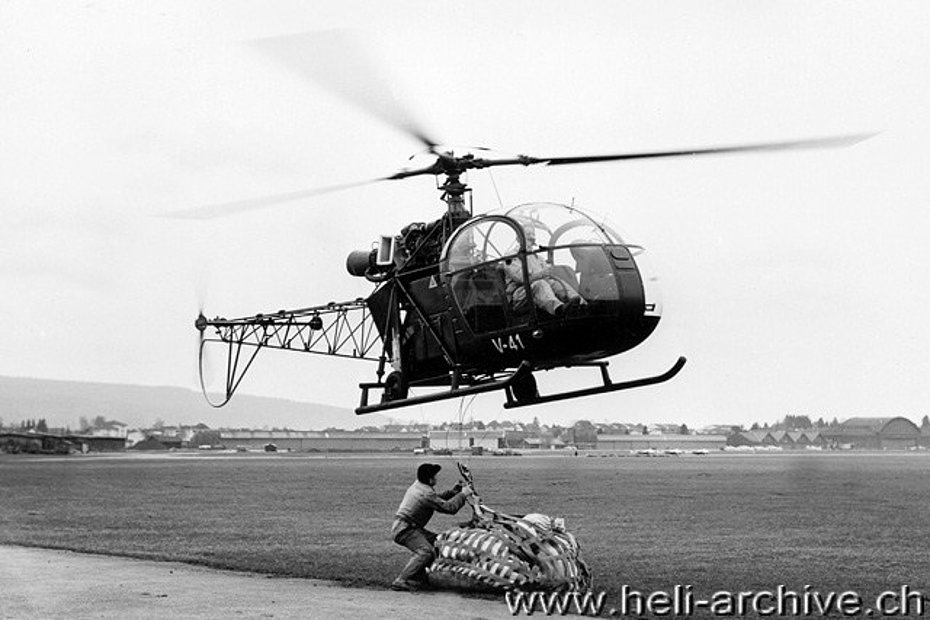
Despite an unexpected compressor stall (compressor stall result in a loss of compressor performance, which can vary in severity from a momentary engine power drop, occurring so quickly that it is barely registered on engine instruments, to a complete loss of power) which forced Henry to land again on the iced suface of the Jungfraujoch, Weber's report was very positive. He wrote in fact enthusiastically that the SE 3130 Alouette 2 was a helicopter of rugged construction, had a wide C.G. travel and a great payload. It was also easy to fly and had excellent flight performances. Ease of maintenance, safety and convertibility were also judged positively.
The Swiss Army, convinced of the good qualities of the Alouette 2, purchased 10 of them in 1958. These were registered V-41 to V-50 (V = Verbindung / liaison). The first two were delivered on the 4th March 1958.
At that time the price for a SE 3130 Alouette 2 equipped with rotor brake, barycentric hook and radio was about Sfr. 330'000 (actual price around 1.4 millions).
In 1961-1962 the Swiss military Alouettes received temporary civil registrations (HB-XBF, HB-XBG, HB-XBH, HB-XBI, HB-XBJ, HB-XBK, HB-XBL, HB-XBM) and flew under the Heliswiss FOM. These aircraft were in fact used to transport partecipants at a conference in Evian/F. In this French resort the Front de Libération National and the French Government signed a treaty ending the Algerian war with a formal cease-fire.
In 1964 the Swiss Army purchased 20 more Alouette 2 (registrations V-51 to V-70) which were used mainly for training, light transportation, reconnaisance and liaison.
The Swiss military helicopters were employed until 1992 when the last 16 still in service were sold out in a public auction for a price varying between 30'000 and 58'000 Sfr.
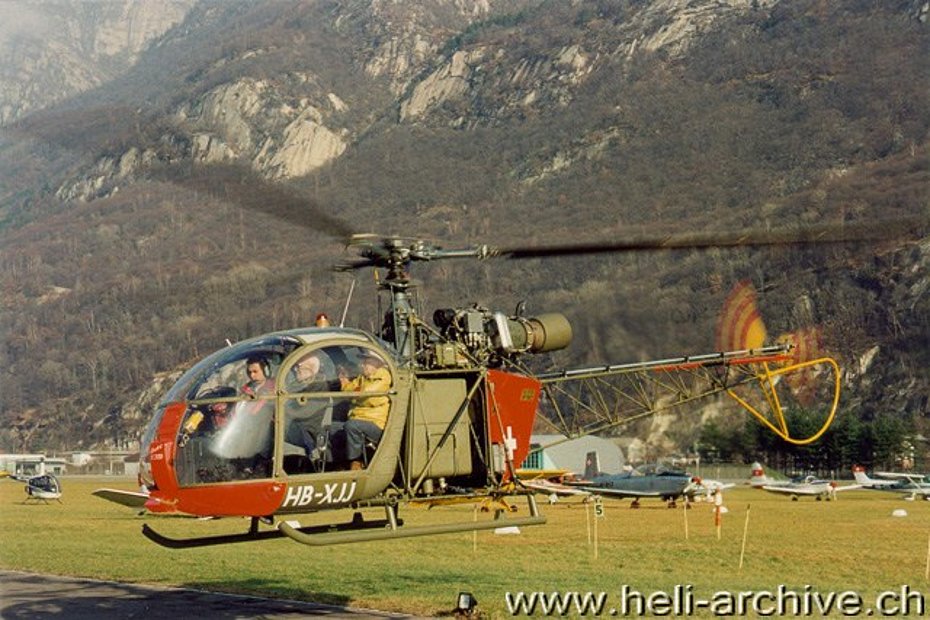
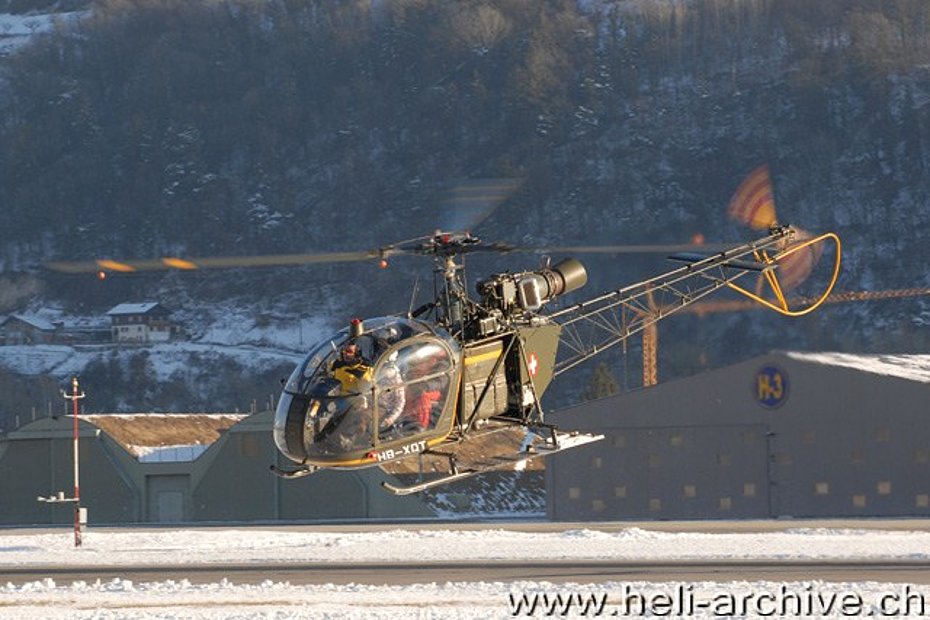
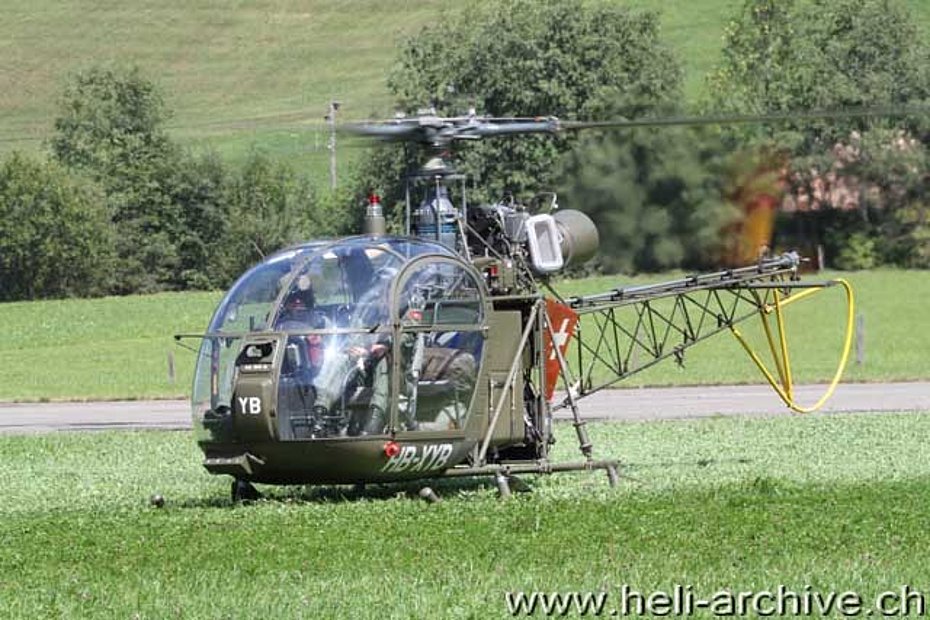
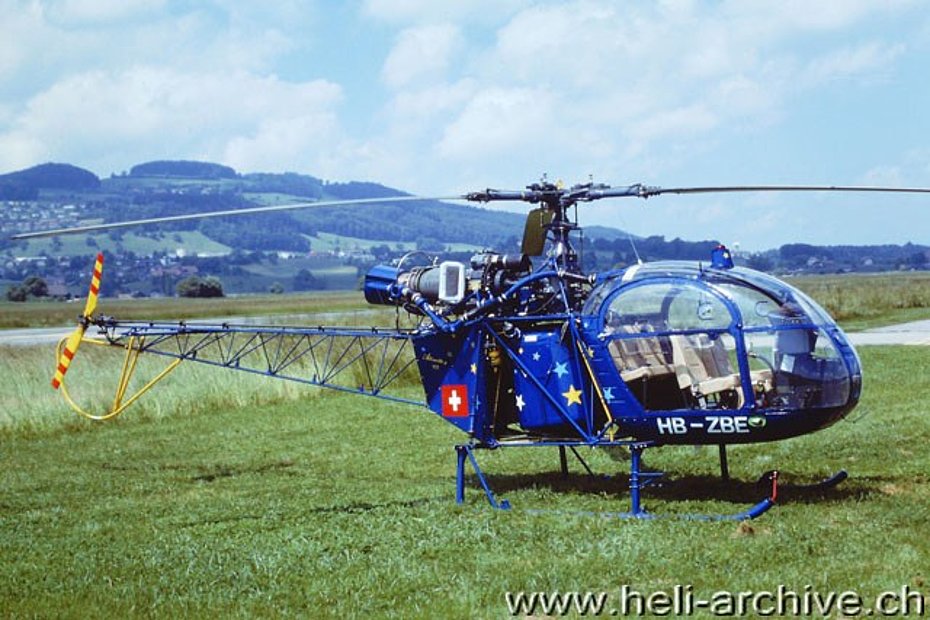
Some of them were purchased by aviation fans who "civilized" their aircraft to be used for private and commercial flights either in Switzerland ar abroad.
The list of those registered in Switzerland originally included: HB-XAQ (s/n 1931 b/y 1964), HB-XBF (s/n 1236 b/y 1958), HB-XJJ (s/n 1903 b/y 1964), HB-XQT (s/n 1650 b/y 1961), HB-XYB (s/n 1915 b/y 1964), HB-XKJ (s/n 1910 b/y 1964).
The complete list of civil SE 3130/SE313B registered in Switzerland to mention the HB-XLG (s/n 1887 b/y 1963) operated by Trans-Héli between 1980 and 1989 and HB-ZBE (s/n 1666 b/y 1961) operated by Air Zermatt between 2000 and 2004.
Among the Swiss operators of the Alouette 2 there was also the Federal Office of Civil Aviation.
There are two more Alouette 2 registered in Switzerland (HB-XBP and HB-XCN) but these were SE 318C and their stories will be told in a separate article.
Currently the Swiss civil aircraft register still includes some Alouette 2, however their future is uncertain. Unfortunately, Eurocopter has set up an end for all Alouette and Lama operations.
During a meeting held in Marignane at the beginning of December 2010, where the major commercial operators of the Alouette 2/3 and SA 315B Lama series were invited, the French manufacturer announced that at the latest by the end of the decade (2020) the Type Certificate will be revoked. In effect this means a stop to commercial operations. It will probably depends from the European Aviation Safety Agency if private flights (in the experimental category) would then still be admitted.
This decision is motivated by several reasons such as for example the difficulty to find the materials and then produce (and certify!) some critical spare parts no longer in production, or the loss of know-how due to lack of mechanics and qualified personnel with specific knowledge.
Another reason is that Eurocopter (and Turboméca as well) want to free themselves from the responsibility they still held for machines scattered throughout the world of which it had lost all traces.
This is a sad news for all the Alouette lovers who had imagined their helicopter lasting as long as the DC-3, but considering the great success obtained by the EC 120B, indicated as the successor of the Alouette 2, the decision of Eurocopter can easily be understood.
Curious notes
Each helicopter manufactured by Sud Aviation/Eurocopter has received the name of an animal (Gazelle, Puma, Lama, Ecureuil). It seems that the name "Alouette - Lark" was suggested in May 1953 by a group of technicians working on the SE 3120 on the airfield of Buc. One morning their attention was captured by a lark flying over the field. The stationary flight of the bird inspired one of the technicians: "Why we don't name our helicopter lark?" he exclaimed. The suggestion was subsequently accepted by the manager of Sud-Est. This marked the beginning of a long tradition.
On the 14th July 2007 the Alouette F-GIJE, which is the oldest Alouette 2 actually flying (it carries s/n 1003 and was built in 1956), took-off from Lognes/F and crossed the Atlantic ocean to meet the Oshkosh (Wisconsin) annual aviation meeting.
The French crew composed by Pascal Petigenet and David Dahdi completed the long trip (via England, Scotland, Faroe Island, Greenland, Canada, USA) in about 65 hours.
Interesting link
Have a look to the website managed by Pierre Gillard which is fully dedicated to the Alouette 2/3 and Lama series. It worths a visit! http://www.alouettelama.com/home/indexen.html
Interesting book
For those who can read French "L'envol des Alouettes, un autout pour la France" written by the French engineer Charles Marchetti is a book which I can highly recommend. It contains a lot of historical information about the Alouette series.
HAB 09/2012

